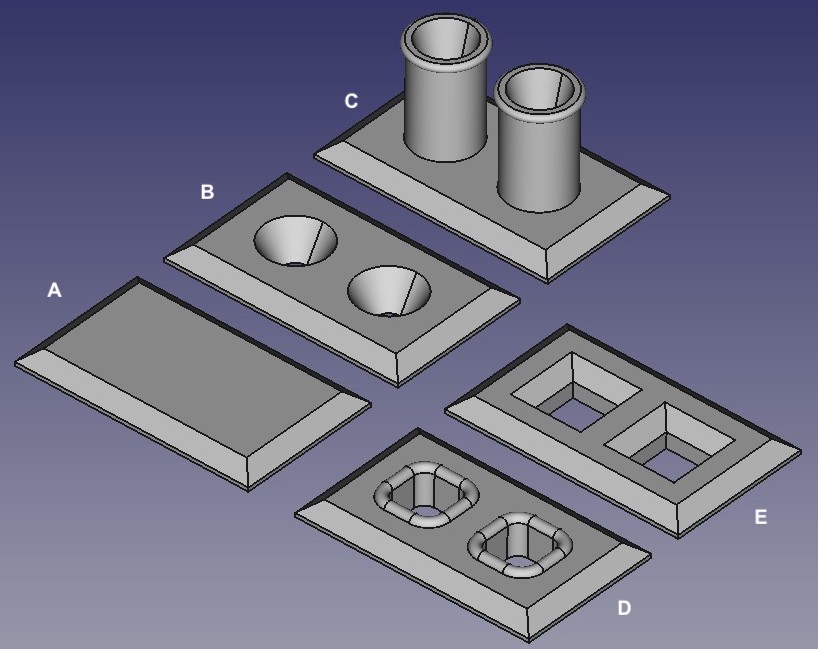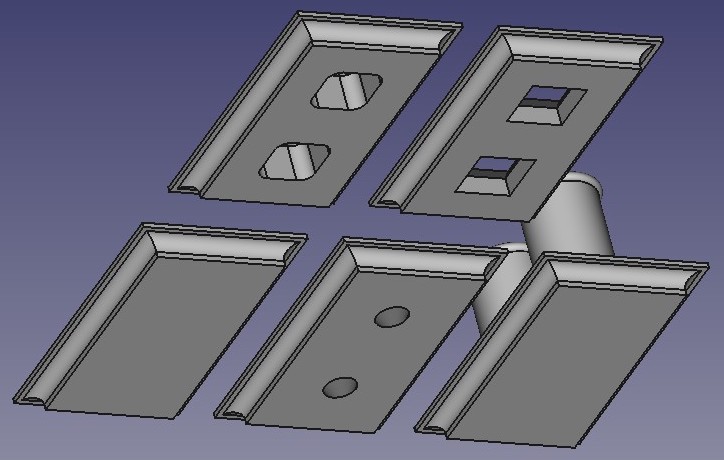Chimney Stack Tops
These are intended to sit on top of your model brick chimney stack, and represent the mortar/cement layer on top of the top layer of bricks in the prototype. The chimney pots are then fitted on top. They are 3D-printed in UV resin, and are available in a selection of styles, sizes, and in a variety of scales. The current range of tops is shown in the illustrations to the right. They are intended to complement my range of chimney pots, which is available here.
All of the tops shown use a circular pot size 12 inches in diameter (at the bottom), or a rectangular flue of similar size, in 4 mm scale. These dimensions refer to the prototype size; the size of the model components will then depend on the scale chosen. Elsewhere on this page dimensions given in inches likewise refer to the prototype size. (A table to help convert prototype inches into model mm is given at the bottom of this page.)
Several top types are available, as shown opposite:
- A, plain. A simple, flat top for you to drill appropriate holes into to take one or more pots as described above. If using with my pots, the holes should be tapered, so drill under size, then add the taper using a tapered reamer or file.
- B, holed. As for A, but with holes for my pots, which have a circular base 1 mm thick with a 30 degree taper (from vertical). Configurable for number and arrangement of pots, and pot diameter. All holes will be the same size, so if using a mixture of pot sizes, use the smallest pot diameter and open the the holes for the larger pots as described above.
- C, with chimneys. As for A/B but with the chimneys moulded onto the top. Please add sufficient appropriate chimney pots to your order If you order a single size/type of pots, no additional information will be needed, but if you use a mixture of chimney sizes/shapes etc, you will need to provide me with the necessary extra information (by e-mail) to arrange the chimneys as you require on your top(s).
- D, with flue liners. As C above, but with flue liners instead of chimneys. The liners can be circular (not shown) or rectangular with rounded corners. The liners are represented by half-round beads around the flue openings.
- E, open flues. As for D, but with no liners. The flues can be circular or rectangular, and configurable for size. The edges of the flue openings are chamfered in the same way as the edges of the overall stack top.
All of the stack tops have a chamfer around the outer top edges, which is configurable for width. This represents the slope applied to the cement of the real thing intended to prevent the accumulation of rainwater. The tops are configurable for length, width and thickness.
All tops also have an additional layer on the underside, slightly smaller than the main top, to provide additional strength, especially for thinner tops. The joint between the layers has a curved fillet to assist with the printing process, so the supporting walls of your chimney stack will need an internal chamfer to accommodate it. The thickness of this layer is configurable – particularly useful for types D and E to help repesent the depth of the flues.
Note: When configuring your stack tops, remember to allow for the thickness of the brick walls that make up the main part of the stack. These may be a single brick thick, or a double thickness of bricks may be used (especially for larger or taller stacks). If you're modelling a real prototype building look at the bond (pattern) of the bricks in the stack: plain or stretcher bond (all bricks are side-on, except at the corners) indicates a single brick thickness; flemish or english bond (a mix of side- and end-on bricks) indicates a double brick thickness. Modern bricks are typically 8.5 x 4 x 3 inches in size, plus a mortar thickness of about 0.5 inches. So, for a single brick thickness stack you should allow at least 4.5 inches between the edges of the pots or flues and the edges of the stack top, while for a double brick thicknes this should be at least 9 inches. Similar rules apply to the internal brick walls that divide a chimney into multiple flues. This results in square or rectangular flues (and defines the size of open-topped flues), and the pots or flue liners are likely to sit in the centre of the corredsponding flue.
Configure Your Tops
To order some of my chimney stack tops you will need to configure each component specification and add the appropriate quantity to your basket. Select the basic top type and size (as described above) you require and click on the "Change Type" button. Further controls will then appear that will allow you to set the various other dimensions etc. of the top. You will also then be able to set the quantity of tops to include in your basket. Each stack top will cost £0.95.
To keep the number of configuration option values down, while still covering the wide range of scales, many of the configurable dimensions are specified in scale inches, rather than model mm. A calculator and look-up table to help convert scale inches into model dimensions (or vice versa) is available here (opens in new browser tab/window).
Note: If you want a chimney top component that is not covered by the standard options below, I will be happy to quote you for a customised component. Please contact me with full details.


